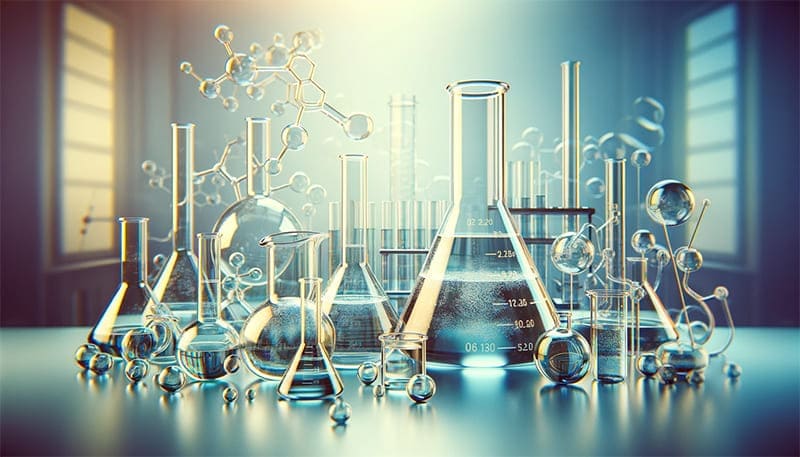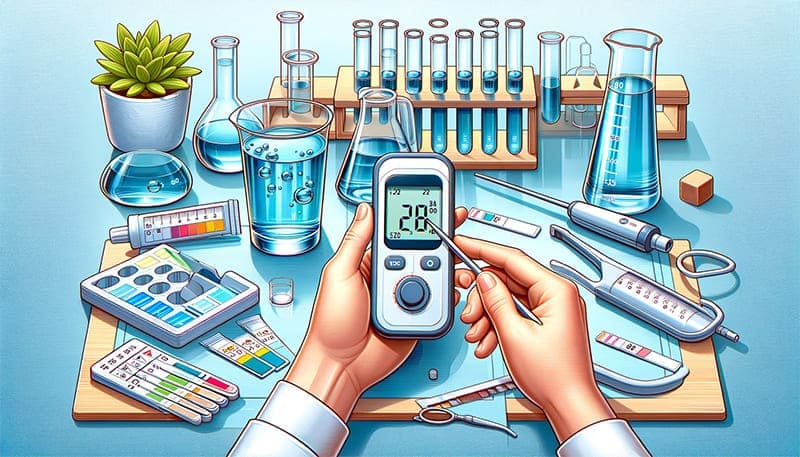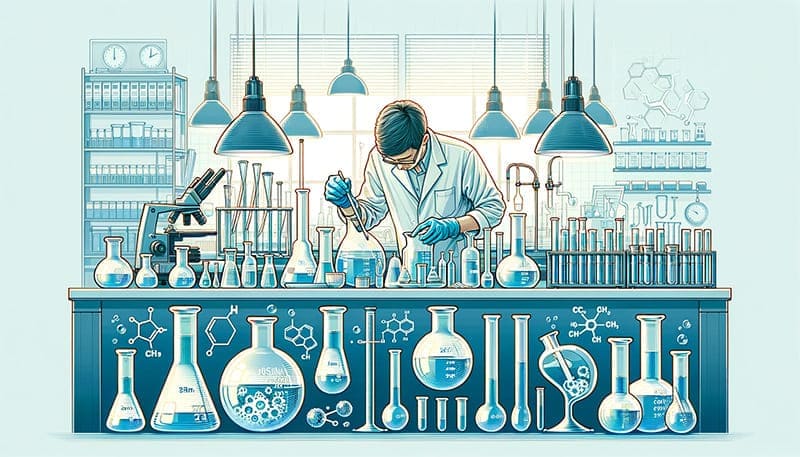Have you ever wondered why some glassware lasts longer while others deteriorate quickly? What makes certain glass items withstand harsh chemical environments, while others fail? The answer lies in their acid-base resistance, a key factor determining the durability and longevity of glassware.
The acidity or alkalinity of glassware refers to its resistance to acidic and alkaline substances, which is a critical measure of its chemical stability and corrosion resistance. The acid-base resistance of glassware is critical in scientific, industrial, and even household settings. This resistance is not just about longevity; it’s about ensuring consistent performance and reliability in various applications.
Keeping you intrigued, let’s delve deeper into why acid-base resistance in glassware is not just a technical detail but a crucial aspect of its functionality.

Exploring the Science Behind Glassware’s Acid-Base Resistance
Why is acid-base resistance so important in glassware? The answer lies in the chemistry of glass itself. Glass, primarily made of silicates, is known for its transparency, chemical stability, and heat resistance. However, its interaction with acids and bases can significantly impact its properties and lifespan.
The measurement of a glass item’s acid-base resistance involves assessing its surface potential difference. When glass comes into contact with a solution, charge transfer occurs, leading to a potential difference. This difference is related to the hydrogen ion concentration in the solution, providing a measure of the glass’s resistance to acidic and alkaline environments.
The Impact of Material and Conditions on Glassware’s Acid-Base Resistance
Various factors influence the acid-base resistance of glassware. It’s important to note that the acidity or alkalinity of glassware can be influenced by various factors such as material composition, surface structure, and usage environment. Therefore, when using glassware, it’s crucial to select the appropriate instruments and experimental conditions based on the specific situation to ensure the accuracy and reliability of experimental results. For precise experiments or measurements with higher requirements, it’s advisable to use glassware made of special materials or treated specially to meet experimental needs. When selecting glassware for specific applications, consider these factors to ensure accuracy and reliability in your experiments.

Practical Steps to Measure Acid-Base Resistance in Glassware
To measure the acidity or alkalinity (PH) of glassware, you can use PH test strips or a digital PH meter. Here are the specific steps for measuring the PH of glassware:
- Prepare Materials and Instruments: Gather a PH test strip, the glassware to be tested, water, a pipette, and a timer. Ensure the glassware is cleaned and dried before use.
- Sampling: Using the pipette, add an appropriate amount of water to the glassware. Stir gently with a finger to ensure the water is well-mixed.
- Measure pH Value: Immerse the PH test strip in the water in the glassware, then remove it and observe the color change. Determine the pH value by comparing the test strip’s color to a standard color chart or following the instructions provided with the test strips.
- Record Results: Note down the measured PH value along with the time and temperature of the measurement. This information is useful for analyzing trends in acidity/alkalinity and understanding influencing factors.
- Data Processing and Analysis: Based on the results, assess and analyze the acidity or alkalinity of the glassware. For instance, compare PH value changes over different time points or analyze the impact of conditions like temperature and pressure on pH values.
It’s important to use appropriate instruments and test strips for measuring the PH of glassware and to handle and record data carefully. For special glassware or measurements requiring higher precision, a digital PH meter is recommended. When using a digital PH meter, follow the instructions for operation, including calibrating the instrument and cleaning the electrode.
In summary, measuring the PH of glassware is a common laboratory procedure. By measuring and analyzing the PH, you can gain insights into the material, performance, and application range of the glassware, which is significant for the accuracy and reliability of experimental results.

Ensuring Longevity: Caring for Glassware in Laboratories and Industries
Proper care and maintenance are vital for maximizing the acid-base resistance and longevity of glassware. Simple practices like regular cleaning, avoiding sudden temperature changes, and handling with care can significantly extend the life of your glass equipment.
Routine cleaning is especially crucial. Residual chemicals, if left unchecked, can react with the glass over time, weakening its structure and reducing its resistance to acids and bases. Always use appropriate cleaning agents and methods suitable for the type of glassware you’re dealing with.
Comparison of Glassware with Other Materials in Acid-Base Applications
To understand why glassware is often preferred over other materials in scenarios involving acid-base reactions, let’s compare glass with two commonly used alternatives: plastic and metal. This comparison will highlight the unique advantages of glassware, particularly in terms of its acid-base resistance, which directly relates to the durability and functionality aspects emphasized in the article’s theme.
Glass vs. Plastic in Acid-Base Resistance
- Chemical Resistance: Glass, especially types like borosilicate, shows superior resistance to a wide range of chemicals compared to most plastics. While certain plastics like Teflon are highly resistant to chemicals, they are not as universally resistant as glass.
- Transparency and Non-Reactivity: Glass is non-reactive and does not leach chemicals into solutions, a crucial factor in many laboratory and industrial settings. Plastics, on the other hand, can sometimes interact with chemicals, leading to contamination.
- Temperature Tolerance: Glass can tolerate higher temperatures than most plastics. When exposed to strong acids and bases, which often require heating, glass maintains its integrity, while plastic may warp or melt.
Glass vs. Metal in Acid-Base Resistance
- Corrosion Resistance: While certain metals like stainless steel are resistant to corrosion, they can still react with strong acids or bases. Glass is generally more resistant to corrosion caused by these substances.
- Purity of Substance: Glass does not impart any ions or metallic taste to substances, maintaining the purity of the contents. Metals can sometimes leach ions into solutions, altering their composition and properties.
- Visibility of Contents: Glass’s transparency allows for easy monitoring of reactions and contents, a feature that metals cannot offer. This transparency is crucial in many laboratory processes and industrial applications.
Why Glass is Often Preferred
Given these comparisons, glassware’s preference in many scenarios, especially those involving strong acids and bases, becomes evident. Its superior chemical resistance, non-reactivity, transparency, and ability to maintain the purity of substances make it an indispensable material in laboratories and industries. This preference aligns perfectly with the article’s focus on the durability and reliability of glassware, where its acid-base resistance is a key factor.
While alternatives like plastic and metal have their own set of advantages and applications, glassware’s unique properties, especially its resistance to acidic and alkaline environments, often make it the material of choice for ensuring accurate, reliable, and safe handling of substances in various scientific and industrial contexts.

Expert Tips on Selecting the Best Acid and Base-Proof Glass Instruments
Selecting the right glass instruments that are resistant to acids and bases is crucial for ensuring both safety and accuracy in various applications. Here are some expert tips to guide you in choosing the best acid and base-proof glassware for your needs.
Understanding the Types of Glass
- Know Your Glass Types: Different types of glass offer varying levels of acid and base resistance. Common types include borosilicate glass, known for its excellent resistance to thermal shock and chemical attack, and soda-lime glass, which is less resistant but more economical.
- Evaluate the Application Requirements: Assess the specific needs of your application. For instance, if you are working with strong acids or bases, opt for glassware made from borosilicate or aluminosilicate glass.
Assessing Quality and Standards
- Check for Quality Standards: Look for glassware that meets recognized industry standards. Glassware that conforms to ASTM (American Society for Testing and Materials) or ISO (International Organization for Standardization) standards is generally a reliable choice.
- Inspect for Flaws: Examine the glassware for any imperfections such as bubbles, streaks, or inclusions. These flaws can weaken the glass and make it more susceptible to damage when exposed to chemicals.
Considering Physical Properties
- Thickness and Durability: Thicker glass tends to be more durable and resistant to breakage. However, it’s also heavier. Balance the need for durability with practicality, especially if the glassware needs to be moved or handled frequently.
- Surface Treatment: Some glass instruments undergo special surface treatments to enhance their chemical resistance. Look for glassware with treated surfaces if you expect it to undergo intense chemical exposure.
Practical Considerations
- Ease of Cleaning: Select glassware that is easy to clean without risking damage. Glassware with complex shapes may be more challenging to clean thoroughly, potentially leaving chemical residues that could affect future experiments.
- Availability of Replacements: Consider the availability and cost of replacements. Opt for glassware that is readily available, so you can quickly replace it if it gets damaged.
Budget and Cost-Effectiveness
- Balancing Cost and Quality: While higher-quality glass may come at a higher price, it often offers better chemical resistance and longevity. Consider the long-term cost savings of investing in more durable glassware.
- Volume Discounts and Kits: For large laboratories or frequent use, look into volume discounts or glassware kits that offer a range of sizes and types at a reduced overall cost.
Safety First
- Prioritize Safety: Always prioritize safety when selecting glassware. Ensure that the chosen glassware can safely contain the chemicals you plan to use, both in terms of chemical compatibility and structural integrity under different conditions.
- Prepare for the Worst: Always have a contingency plan in case of glassware failure. This includes having appropriate safety equipment on hand and knowing the procedures for dealing with chemical spills or broken glass.
By following these expert tips, you can make informed decisions when selecting acid and base-proof glass instruments, ensuring that your choice enhances the safety, accuracy, and efficiency of your work.
Conclusion
Understanding and prioritizing the acid-base resistance of glassware is imperative for enduring success in scientific and industrial endeavors. Empower your work with the right choices—select glassware that aligns with your specific needs, uphold stringent quality standards, and embrace diligent care and maintenance. Let’s commit to making informed decisions, enhancing safety, and achieving excellence in every experiment and process. Your proactive approach today shapes a safer, more efficient, and successful tomorrow.










